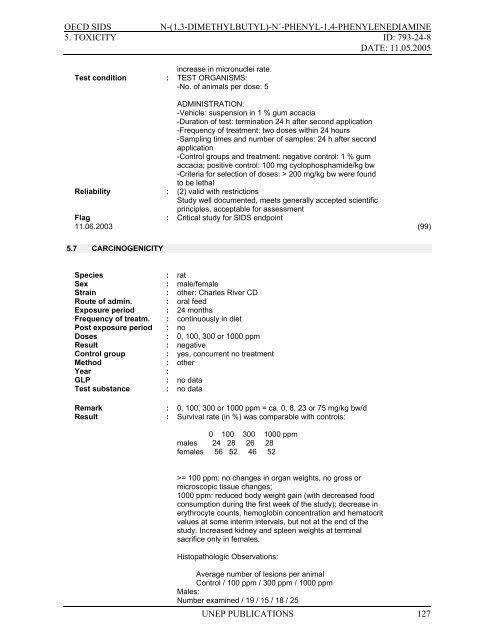N-(1,3-Dimethylbutyl)-N
N-(1,3-Dimethylbutyl)-N
N-(1,3-Dimethylbutyl)-N
You also want an ePaper? Increase the reach of your titles
YUMPU automatically turns print PDFs into web optimized ePapers that Google loves.
OECD SIDS<br />
N-(1,3-DIMETHYLBUTYL)-N´-PHENYL-1,4-PHENYLENEDIAMINE<br />
5. TOXICITY ID: 793-24-8<br />
DATE: 11.05.2005<br />
increase in micronuclei rate.<br />
Test condition : TEST ORGANISMS:<br />
-No. of animals per dose: 5<br />
ADMINISTRATION:<br />
-Vehicle: suspension in 1 % gum accacia<br />
-Duration of test: termination 24 h after second application<br />
-Frequency of treatment: two doses within 24 hours<br />
-Sampling times and number of samples: 24 h after second<br />
application<br />
-Control groups and treatment: negative control: 1 % gum<br />
accacia; positive control: 100 mg cyclophosphamide/kg bw<br />
-Criteria for selection of doses: > 200 mg/kg bw were found<br />
to be lethal<br />
Reliability : (2) valid with restrictions<br />
Study well documented, meets generally accepted scientific<br />
principles, acceptable for assessment<br />
Flag : Critical study for SIDS endpoint<br />
11.06.2003 (99)<br />
5.7 CARCINOGENICITY<br />
Species : rat<br />
Sex : male/female<br />
Strain : other: Charles River CD<br />
Route of admin. : oral feed<br />
Exposure period : 24 months<br />
Frequency of treatm. : continuously in diet<br />
Post exposure period : no<br />
Doses : 0, 100, 300 or 1000 ppm<br />
Result : negative<br />
Control group : yes, concurrent no treatment<br />
Method : other<br />
Year :<br />
GLP : no data<br />
Test substance : no data<br />
Remark : 0, 100, 300 or 1000 ppm = ca. 0, 8, 23 or 75 mg/kg bw/d<br />
Result : Survival rate (in %) was comparable with controls:<br />
0 100 300 1000 ppm<br />
males 24 28 26 28<br />
females 56 52 46 52<br />
>= 100 ppm: no changes in organ weights, no gross or<br />
microscopic tissue changes;<br />
1000 ppm: reduced body weight gain (with decreased food<br />
consumption during the first week of the study); decrease in<br />
erythrocyte counts, hemoglobin concentration and hematocrit<br />
values at some interim intervals, but not at the end of the<br />
study. Increased kidney and spleen weights at terminal<br />
sacrifice only in females.<br />
Histopathologic Observations:<br />
Average number of lesions per animal<br />
Control / 100 ppm / 300 ppm / 1000 ppm<br />
Males:<br />
Number examined / 19 / 15 / 18 / 25<br />
UNEP PUBLICATIONS 127
















